



Biodiv Sci ›› 2023, Vol. 31 ›› Issue (1): 22370. DOI: 10.17520/biods.2022370 cstr: 32101.14.biods.2022370
• Original Papers: Animal Diversity • Previous Articles Next Articles
Keyi Wu1, Wenda Ruan1, Difeng Zhou1, Qingchen Chen1,*( ), Chengyun Zhang1, Xinyuan Pan2, Shang Yu3, Yang Liu4, Rongbo Xiao5
), Chengyun Zhang1, Xinyuan Pan2, Shang Yu3, Yang Liu4, Rongbo Xiao5
Received:2022-06-30
Accepted:2022-11-24
Online:2023-01-20
Published:2022-12-02
Contact:
*Qingchen Chen, E-mail: qcchen@gzhu.edu.cn
Keyi Wu, Wenda Ruan, Difeng Zhou, Qingchen Chen, Chengyun Zhang, Xinyuan Pan, Shang Yu, Yang Liu, Rongbo Xiao. Syllable clustering analysis-based passive acoustic monitoring technology and its application in bird monitoring[J]. Biodiv Sci, 2023, 31(1): 22370.

Fig. 1 The whole structure of deep unsupervised syllable clustering. The sound is collected by the pickup terminal, each bird song is located and extracted by the syllable extraction algorithm, and the syllable classifier is obtained by alternate learning of representation learning and Dirichlet process mixed model (DPMM).
| 1: 输入input: 包含N个样本的原始音频X1:N, 每帧信号样本数T, 相邻语音帧偏移参数H, 音高检测阈值θpitch |
|---|
| 2: |
| 3: |
| 4: for |
| 5: |
| 6: |
| 7: |
| 8: |
| 9: |
| 10: |
| 11: |
| 12:end for |
| 13: |
| 14: |
| 15: Mask |
| 16: return |
Table 1 The multi-feature based syllable detection and extraction algorithm proposed in this paper
| 1: 输入input: 包含N个样本的原始音频X1:N, 每帧信号样本数T, 相邻语音帧偏移参数H, 音高检测阈值θpitch |
|---|
| 2: |
| 3: |
| 4: for |
| 5: |
| 6: |
| 7: |
| 8: |
| 9: |
| 10: |
| 11: |
| 12:end for |
| 13: |
| 14: |
| 15: Mask |
| 16: return |
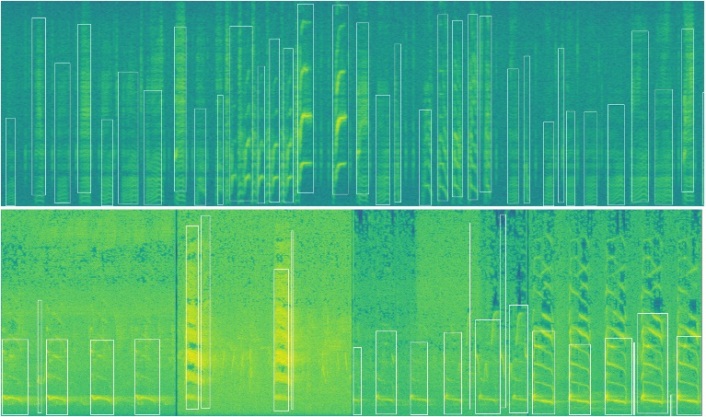
Fig. 2 The syllables of Lonchura striata (top) and Baiyun Mountain birds (bottom) detected and automatically labeled. The part highlighted with white box in the spectrogram are syllables.
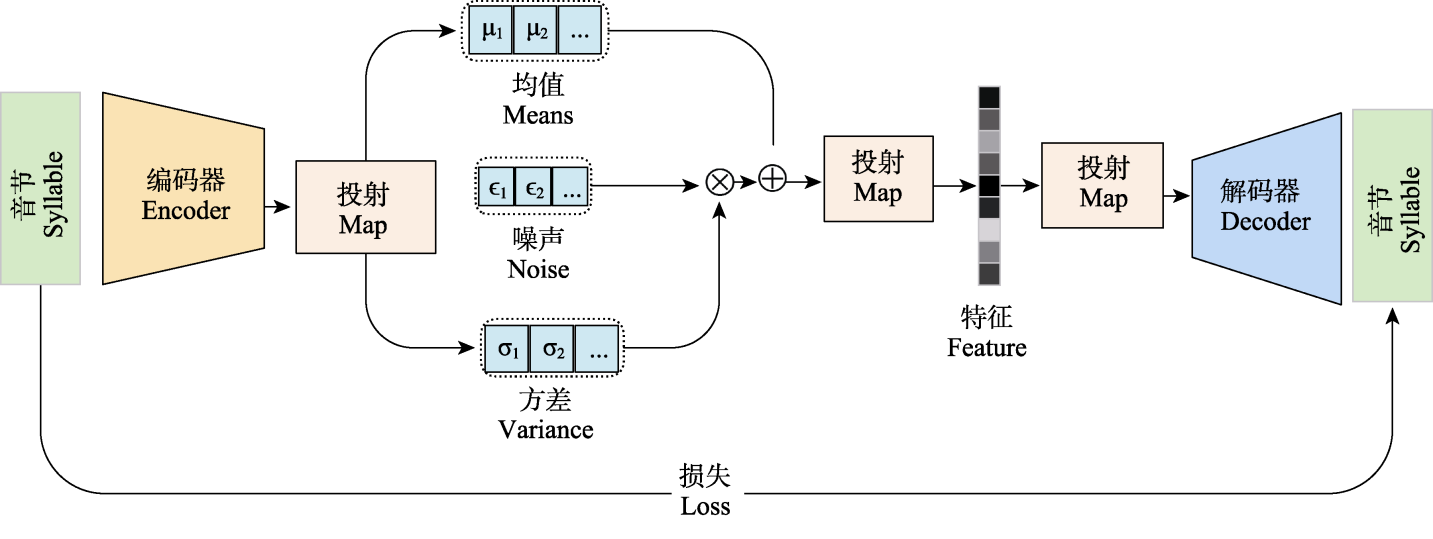
Fig. 3 Schematic diagram of bird song syllable clustering based on variational encoder. The encoder projects the syllables into a low-dimensional latent space, and the decoder reconstructs the syllables using the mean and variance vectors.
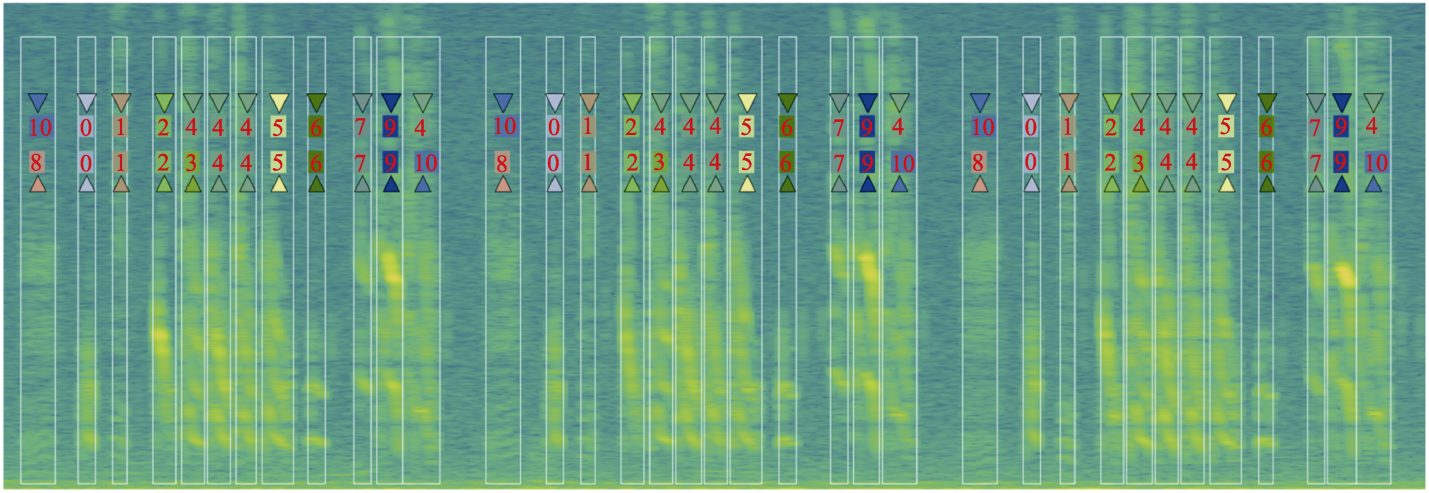
Fig. 4 Syllable detection and annotation results after unsupervised clustering of Lonchura striata repertoire (Bird 032312). The white boxes are marked as syllable ranges, the number tag above the syllable is a pseudo tag assigned by unsupervised clustering, and the number below the syllable corresponds to the syllable tag marked by the expert.
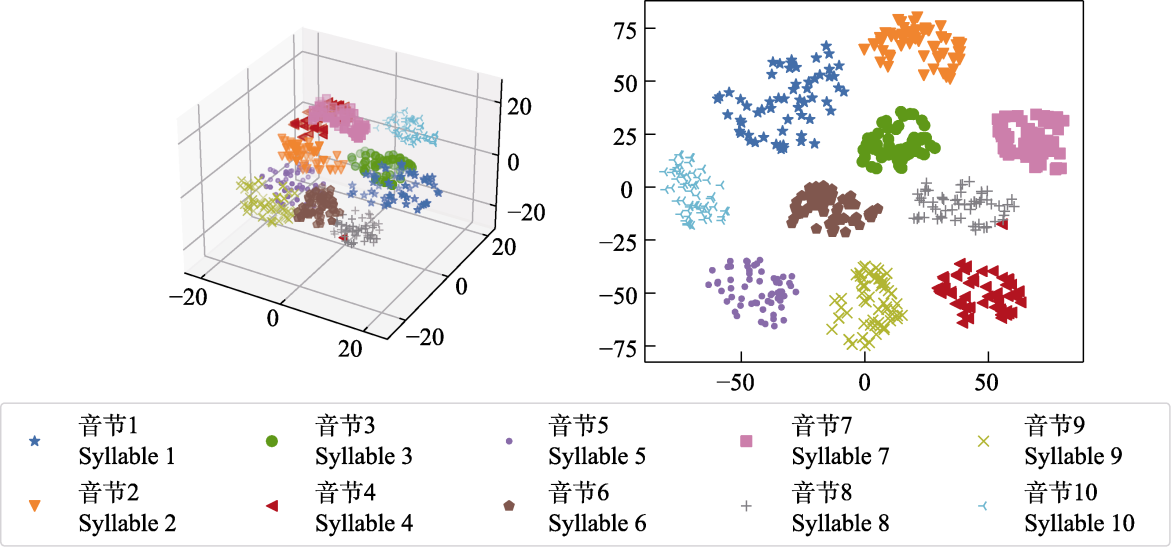
Fig. 5 The syllable clustering results of Lonchura striata repertoire Bird 032312 are visualized; the 64-dimensional features are reduced to 3 and 2 dimensions using the t-SNE dimensionality reduction method.
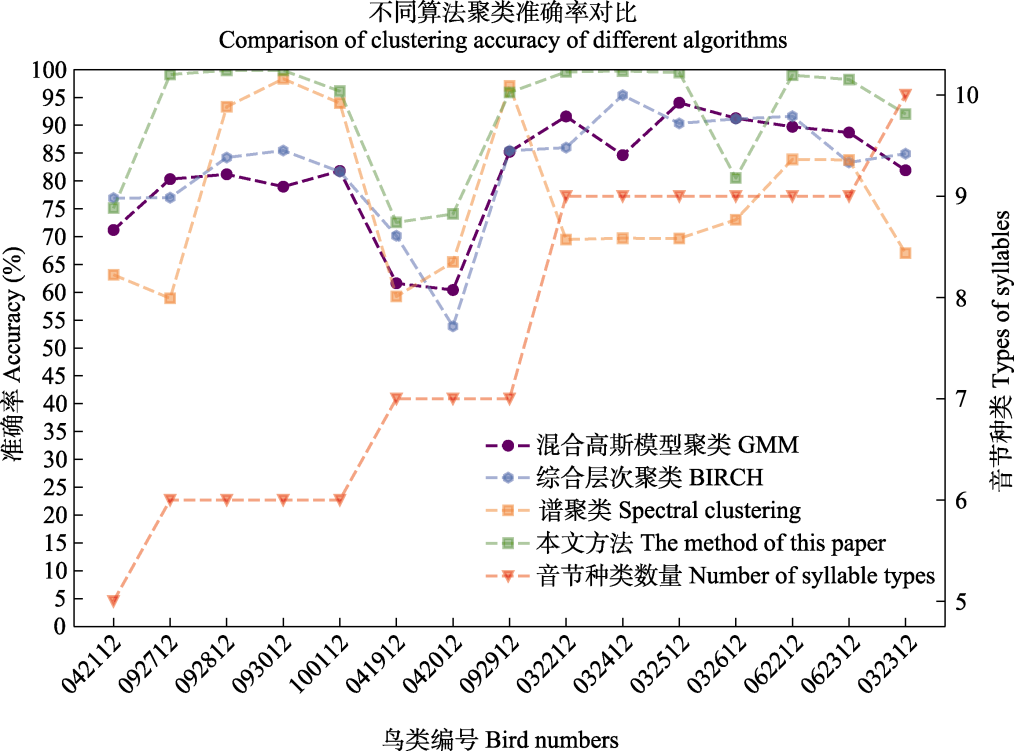
Fig. 6 Comparison of the clustering performance of traditional clustering algorithms and the proposed deep learning-based methods in the Lonchura striata song library. The abscissa is the number of each bird, the ordinate (left) is the clustering accuracy, and the ordinate (right) represents the number of syllables. The red line is the number of syllable types, and the cluster number of each bird is sorted in ascending order according to the number of syllable species of each bird.
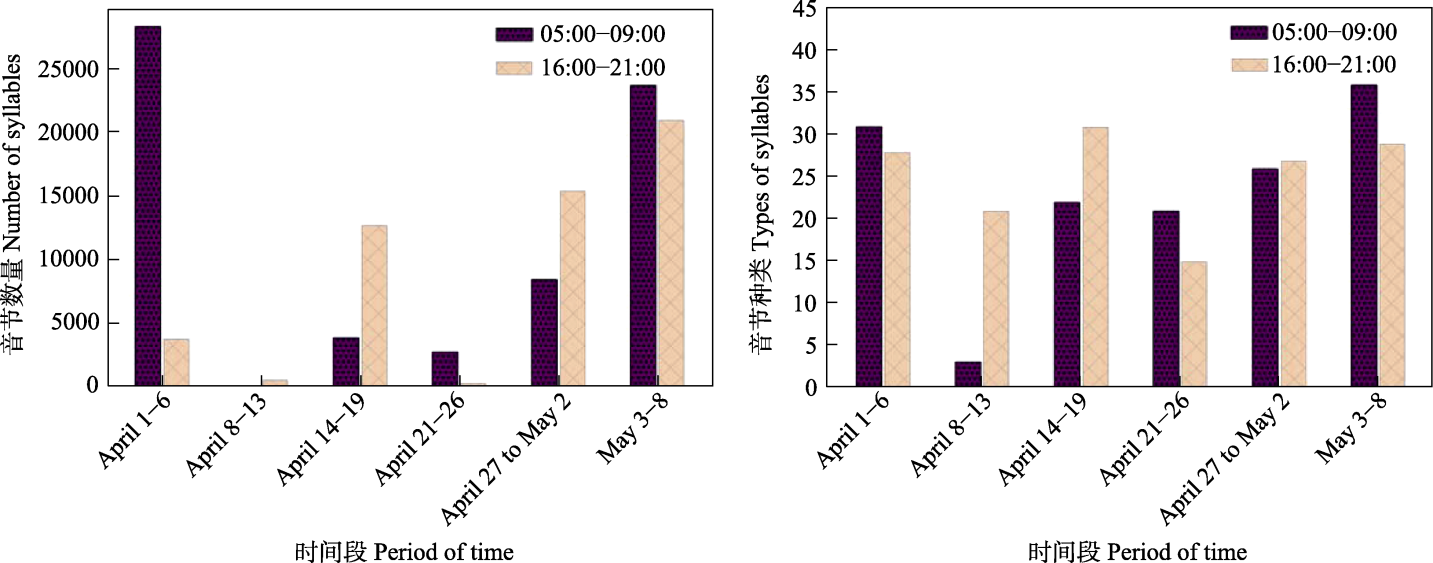
Fig. 7 Statistics on the number of syllables of birds at a monitoring site in Baiyunshan Park: (left) the number of syllables and (right) the number of syllables. The number and types of bird syllables are count every 6 days from April 1, 2022 to May 9, 2022. The statistical time period is from 5:00 to 9:00 in the morning, and from 16:00 to 21:00 in the evening.
| [1] |
Alghamdi A, Mehtab T, Iqbal R, Leeza M, Islam N, Hamdi M, Shaikh A (2021) Automatic classification of monosyllabic and multisyllabic birds using PDHF. Electronics, 10, 624.
DOI URL |
| [2] |
Baker MC, Cunningham MA (1985) The biology of bird-song dialects. Behavioral and Brain Sciences, 8, 85-100.
DOI URL |
| [3] | Bilger HT, Vertosick E, Vickers A, Kaczmarek K, Prum RO (2021) Higher-order musical temporal structure in bird song. Frontiers in Psychology, 12, 629456. |
| [4] |
Botero CA, Rossman RJ, Caro LM, Stenzler LM, Lovette IJ, de Kort SR, Vehrencamp SL (2009) Syllable type consistency is related to age, social status and reproductive success in the tropical mockingbird. Animal Behaviour, 77, 701-706.
DOI URL |
| [5] |
Bradfer-Lawrence T, Gardner N, Bunnefeld L, Bunnefeld N, Willis SG, Dent DH (2019) Guidelines for the use of acoustic indices in environmental research. Methods in Ecology and Evolution, 10, 1796-1807.
DOI |
| [6] |
Cohen Y, Nicholson D, Gardner TJ (2020) TweetyNet: A neural network that enables high-throughput, automated annotation of birdsong. bioRxiv, doi:10.1101/2020.08.28. 272088.
DOI |
| [7] | Cui P, Deng WH (2007) Review on the status and development of bird community research. Chinese Journal of Zoology, 42, 149-158. (in Chinese with English abstract) |
| [崔鹏, 邓文洪 (2007) 鸟类群落研究进展. 动物学杂志, 42, 149-158.] | |
| [8] | Fagerlund S (2004) Automatic Recognition of Bird Species by Their Sounds. PhD thesis, Helsinki University of Technology, Helsinki. |
| [9] | Geberzahn N, Gahr M (2011) Undirected (solitary) birdsong in female and male blue-capped cordon-bleus (Uraeginthus cyanocephalus) and its endocrine correlates. PLoS ONE, 6, e26485. |
| [10] |
Große Ruse M, Hasselquist D, Hansson B, Tarka M, Sandsten M (2016) Automated analysis of song structure in complex birdsongs. Animal Behaviour, 112, 39-51.
DOI URL |
| [11] |
Gutiérrez RJ, Cody M, Courtney S, Franklin AB (2007) The invasion of barred owls and its potential effect on the spotted owl: A conservation conundrum. Biological Invasions, 9, 181-196.
DOI URL |
| [12] | He KM, Zhang XY, Ren SQ, Sun J (2016) Deep residual learning for image recognition. 2016 IEEE Conference on Computer Vision and Pattern Recognition. Las Vegas, NV, USA. IEEE, 770-778. |
| [13] |
Heck M, Sakti S, Nakamura S (2018) Dirichlet process mixture of mixtures model for unsupervised subword modeling. IEEE/ACM Transactions on Audio, Speech, and Language Processing, 26, 2027-2042.
DOI URL |
| [14] |
Illes AE (2015) Context of female bias in song repertoire size, singing effort, and singing independence in a cooperatively breeding songbird. Behavioral Ecology and Sociobiology, 69, 139-150.
DOI URL |
| [15] | Katahira K, Suzuki K, Okanoya K, Okada M (2011) Complex sequencing rules of birdsong can be explained by simple hidden Markov processes. PLoS ONE, 6, e24516. |
| [16] | Kingma DP, Welling M (2013) Auto-encoding variational Bayes. arXiv: 1312.6114. https://arxiv.org/abs/1312.6114. |
| [17] |
Kong QQ, Cao Y, Iqbal T, Wang YX, Wang WW, Plumbley MD (2020) PANNs: Large-scale pretrained audio neural networks for audio pattern recognition. IEEE/ACM Transactions on Audio, Speech, and Language Processing, 28, 2880-2894.
DOI URL |
| [18] | Koumura T, Okanoya K (2016) Automatic recognition of element classes and boundaries in the birdsong with variable sequences. PLoS ONE, 11, e0159188. |
| [19] |
Lindsay B, McLachlan GL, Basford KE, Dekker M (1989) Mixture models: Inference and applications to clustering. Journal of the American Statistical Association, 84, 337.
DOI URL |
| [20] | Lobato M, Vellema M, Gahr C, Leitão A, de Lima SMA, Geberzahn N, Gahr M (2015) Mismatch in sexual dimorphism of developing song and song control system in blue-capped cordon-bleus, a songbird species with singing females and males. Frontiers in Ecology and Evolution, 3, 117. |
| [21] | Marck A, Vortman Y, Kolodny O, Lavner Y (2022) Identification, analysis and characterization of base units of bird vocal communication: The white spectacled bulbul (Pycnonotus xanthopygos) as a case study. Frontiers in Behavioral Neuroscience, 15, 812939. |
| [22] | Micheli-Tzanakou E (2017) Supervised and Unsupervised Pattern Recognition:Feature Extraction and Computational intelligence. CRC Press, Boca Raton. |
| [23] | Morita T, Koda H, Okanoya K, Tachibana RO (2021) Measuring context dependency in birdsong using artificial neural networks. PLoS Computational Biology, 17, e1009707. |
| [24] |
O’Reilly C, Marples NM, Kelly DJ, Harte N (2016) YIN-Bird: Improved Pitch Tracking for Bird Vocalisations Interspeech, ISCA. doi: 10.21437/Interspeech.2016-90.
DOI |
| [25] |
Pillay R, Fletcher RJ Jr, Sieving KE, Udell BJ, Bernard H (2019) Bioacoustic monitoring reveals shifts in breeding songbird populations and singing behaviour with selective logging in tropical forests. Journal of Applied Ecology, 56, 2482-2492.
DOI URL |
| [26] |
Planqué R, Britton NF, Slabbekoorn H (2014) On the maintenance of bird song dialects. Journal of Mathematical Biology, 68, 505-531.
DOI PMID |
| [27] |
Potamitis I, Ntalampiras S, Jahn O, Riede K (2014) Automatic bird sound detection in long real-field recordings: Applications and tools. Applied Acoustics, 80, 1-9.
DOI URL |
| [28] |
Sainburg T, Thielk M, Gentner TQ (2019) Latent space visualization, characterization, and generation of diverse vocal communication signals. bioRxiv, doi: 10.1101/870311.
DOI |
| [29] |
Snell-Rood EC (2012) The effect of climate on acoustic signals: Does atmospheric sound absorption matter for bird song and bat echolocation. The Journal of the Acoustical Society of America, 131, 1650-1658.
DOI URL |
| [30] | Steinfath E, Palacios-Muñoz A, Rottschäfer JR, Yuezak D, Clemens J (2021) Fast and accurate annotation of acoustic signals with deep neural networks. eLife, 10, 68837. |
| [31] |
Stowell D, Wood MD, Pamuła H, Stylianou Y, Glotin H (2019) Automatic acoustic detection of birds through deep learning: The first Bird Audio Detection challenge. Methods in Ecology and Evolution, 10, 368-380.
DOI |
| [32] |
Suzuki TN (2021) Animal linguistics: Exploring referentiality and compositionality in bird calls. Ecological Research, 36, 221-231.
DOI URL |
| [33] | Torres-García AA, Mendoza-Montoya O, Reyes-García CA, Villaseñor-Pineda L (2021) Biosignal Processing and Classification Using Computational Learning and Intelligence, pp. 3-6. Elsevier, Amsterdam. |
| [34] | Von Luxburg U (2007) A tutorial on spectral clustering. Statistics and Computing, 17, 395-416. |
| [35] | Wang Q, Lü XG (2007) Application of water bird to monitor and evaluate wetland ecosystem. Wetland Science, 5, 274-281. (in Chinese with English abstract) |
| [王强, 吕宪国 (2007) 鸟类在湿地生态系统监测与评价中的应用. 湿地科学, 5, 274-281.] | |
| [36] | Xie J, Towsey M, Truskinger A, Eichinski P, Zhang JL, Roe P (2015) Acoustic classification of Australian anurans using syllable features. 2015 IEEE Tenth International Conference on Intelligent Sensors, Sensor Networks and Information Processing (ISSNIP). April 7-9, 2015, Singapore. IEEE, 1-6. |
| [37] | Yang CC, Cai Y, Liang W (2009) Bird diversity in parks of Guangzhou. Journal of Hainan Normal University (Natural Science), 22, 196-199. (in Chinese with English abstract) |
| [杨灿朝, 蔡燕, 梁伟 (2009) 广州市区各公园的鸟类多样性比较. 海南师范大学学报(自然科学版), 22, 196-199.] | |
| [38] | Yang LX, Cheung NM, Li JY, Fang J (2019) Deep clustering by Gaussian mixture variational autoencoders with graph embedding. 2019 IEEE/CVF International Conference on Computer Vision (ICCV). October 27-November 2, 2019, Seoul, Korea (South). IEEE, 6439-6448. |
| [39] | Zhang T, Ramakrishnan R, Livny M (1996) Birch: An efficient data clustering method for very large databases. SIGMOD Record (ACM Special Interest Group on Management of Data), 25, 103-114. |
| [40] | Zhou S, Xu HJ, Zheng ZN, Chen JW li Z, Bu JJ, Wu J, Wang X, Zhu WW, Ester M (2022) A comprehensive survey on deep clustering: Taxonomy, challenges, and future directions. arXiv: 2206.07579. https://arxiv.org/abs/2206.07579. |
| [1] | Haotian Bai, Shang Yu, Xinyuan Pan, Jiale Ling, Juan Wu, Kaiqi Xie, Yang Liu, Xueye Chen. AI-assisted recognition for passive acoustic monitoring of birds in urban wetland parks [J]. Biodiv Sci, 2024, 32(8): 24188-. |
| [2] | Qianrong Guo, Shufei Duan, Jie Xie, Xueyan Dong, Zhishu Xiao. Advances in bird sound annotation methods for passive acoustic monitoring [J]. Biodiv Sci, 2024, 32(10): 24313-. |
| [3] | Lei Chen, Zhiyong Xu, Pukun Su, Xiaotian Lai, Zhao Zhao. Exploring the application of frequency-dependent acoustic diversity index in human-dominated areas [J]. Biodiv Sci, 2024, 32(10): 24286-. |
| [4] | Yingying Liu, Lixin Gong, Hao Zeng, Jiang Feng, Yongjun Dong, Lei Wang, Tinglei Jiang. Application of passive acoustic monitoring in Chiropteran research [J]. Biodiv Sci, 2024, 32(10): 24233-. |
| [5] | Wantao Huang, Zezhou Hao, Zixin Zhang, Zhishu Xiao, Chengyun Zhang. A comparison of bird sound recognition performance among acoustic recorders [J]. Biodiv Sci, 2024, 32(10): 24273-. |
| [6] | Le Li, Chengyun Zhang, Nancai Pei, Bingtao Gao, Na Wang, Jiarui Li, Ruichen Wu, Zezhou Hao. Correlation analysis of urban green landscape patterns and bird diversity based on passive acoustic monitoring technology [J]. Biodiv Sci, 2024, 32(10): 24296-. |
| [7] | Zezhou Hao, Chengyun Zhang, Le Li, Bingtao Gao, Wei Zeng, Chun Wang, Zixuan Wang, Wantao Huang, Yue Zhang, Nancai Pei, Zhishu Xiao. Applications of passive acoustic monitoring and evaluation in urban bird research [J]. Biodiv Sci, 2024, 32(10): 24123-. |
| [8] | Jiangjian Xie, Chen Shen, Feiyu Zhang, Zhishu Xiao. Cross-regional bird species recognition method integrating audio and ecological niche information [J]. Biodiv Sci, 2024, 32(10): 24259-. |
| [9] | Zhishu Xiao, Jianguo Cui, Daiping Wang, Zhitao Wang, Jinhong Luo, Jie Xie. Interdisciplinary development trends of contemporary bioacoustics and the opportunities for China [J]. Biodiv Sci, 2023, 31(1): 22423-. |
| [10] | Haigang Ma, Penglai Fan. Application, progress, and future perspective of passive acoustic monitoring in terrestrial mammal research [J]. Biodiv Sci, 2023, 31(1): 22374-. |
| [11] | Xiaofeng Niu, Xiaomei Wang, Yan Zhang, Zhipeng Zhao, Enyuan Fan. Integration and application of sturgeon identification methods [J]. Biodiv Sci, 2022, 30(6): 22034-. |
| [12] | Enzhu Zhong, Zhenhua Guan, Xingce Zhou, Youjie Zhao, Han Li, Shaobin Tan, Kunrong Hu. Application of passive acoustic monitoring technology in the monitoring of western black crested gibbons [J]. Biodiv Sci, 2021, 29(1): 109-117. |
| [13] | Jiaxin Kong, Zhaochen Zhang, Jian Zhang. Classification and identification of plant species based on multi-source remote sensing data: Research progress and prospect [J]. Biodiv Sci, 2019, 27(7): 796-812. |
| [14] | Yun Cao, Wenjing Shen, Lian Chen, Feilong Hu, Lei Zhou, Haigen Xu. Application of metabarcoding technology in studies of fungal diversity [J]. Biodiv Sci, 2016, 24(8): 932-939. |
| [15] | Tai Wang, Yanping Zhang, Lihong Guan, Yanyan Du, Zhongyu Lou, Wenlong Jiao. Current freshwater fish resources and the application of DNA barcoding in species identification in Gansu Province [J]. Biodiv Sci, 2015, 23(3): 306-313. |
| Viewed | ||||||
|
Full text |
|
|||||
|
Abstract |
|
|||||
Copyright © 2022 Biodiversity Science
Editorial Office of Biodiversity Science, 20 Nanxincun, Xiangshan, Beijing 100093, China
Tel: 010-62836137, 62836665 E-mail: biodiversity@ibcas.ac.cn ![]()